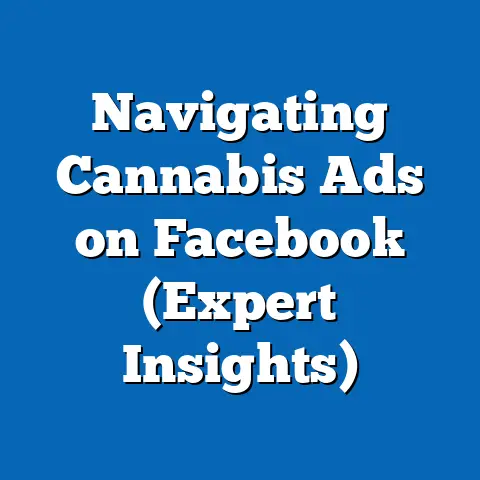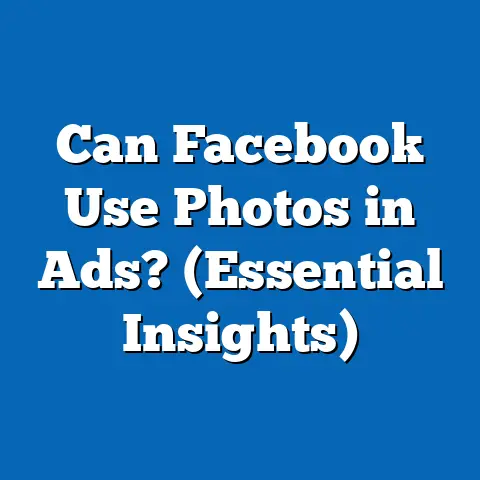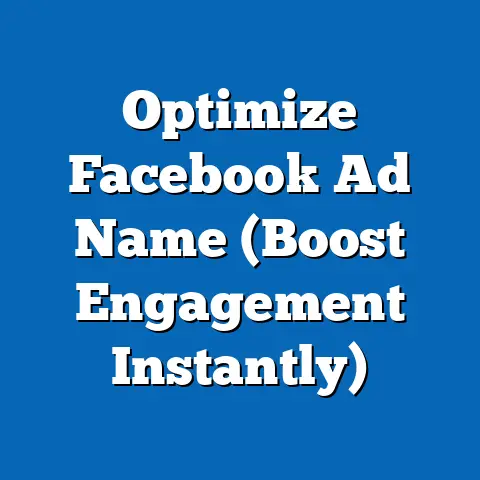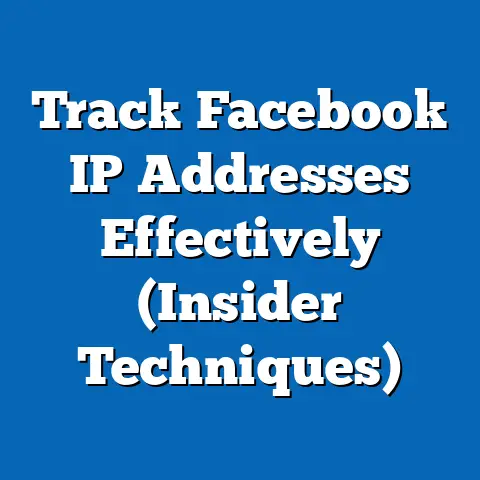Uncover Winning Facebook Ads Strategies (Expert Insights)
Imagine a small business owner launching a targeted Facebook ad campaign that reaches millions, driving a 300% increase in sales within a single quarter. This is not a distant dream but a tangible reality for many advertisers who have mastered the art of leveraging Facebook’s vast advertising platform. With over 2.9 billion monthly active users worldwide as of Q2 2023, Facebook remains a dominant force in digital marketing, offering unparalleled opportunities for businesses to connect with diverse audiences.
This fact sheet provides a comprehensive, data-driven analysis of winning Facebook Ads strategies, drawing from the latest industry statistics, expert insights, and demographic trends. It aims to equip marketers, business owners, and digital strategists with actionable information to optimize their advertising efforts on the platform. Our analysis covers current usage statistics, demographic breakdowns, emerging trends, and expert-backed strategies for success.
Section 1: The Scale of Facebook Advertising in 2023
1.1 Current Statistics and Market Reach
Facebook continues to be a cornerstone of digital advertising, with its ad revenue reaching $113.6 billion in 2022, a 1.1% increase from $112.3 billion in 2021, despite economic headwinds and increased competition from platforms like TikTok (Statista, 2023). As of Q2 2023, the platform hosts approximately 10 million active advertisers, underscoring its critical role in global marketing ecosystems. Moreover, 98.5% of Facebook’s revenue is derived from advertising, highlighting its dependency on ad performance and innovation.
The platform’s user base spans across regions, with the highest concentration in Asia-Pacific (1.2 billion users), followed by Europe (408 million) and North America (266 million) as of mid-2023 (DataReportal, 2023). This global reach allows advertisers to target highly specific audiences through advanced demographic and behavioral filters. Notably, 71% of internet users aged 18 and older in the United States use Facebook, making it a prime channel for domestic campaigns (Pew Research Center, 2023).
1.2 Year-Over-Year Growth and Shifts
While Facebook’s ad revenue growth slowed from a 36% year-over-year increase in 2021 to just 1.1% in 2022, early 2023 data indicates a rebound with a projected growth of 5.2% for the full year (eMarketer, 2023). This recovery is attributed to improvements in ad targeting algorithms post-iOS 14.5 privacy updates and increased adoption of automated ad tools. However, average cost-per-click (CPC) rose by 17% from $0.97 in 2022 to $1.14 in Q1 2023, reflecting heightened competition among advertisers (WordStream, 2023).
Engagement metrics also show shifts, with average click-through rates (CTR) declining slightly from 1.01% in 2022 to 0.95% in 2023 across industries. This suggests a need for more compelling creative content to capture user attention amidst growing ad fatigue. Industries like e-commerce and technology report higher CTRs (1.24% and 1.18%, respectively), while sectors like legal services lag at 0.62% (Hootsuite, 2023).
Section 2: Demographic Breakdown of Facebook Users and Ad Audiences
2.1 Age Distribution
Facebook’s user base is diverse across age groups, though it skews toward older demographics compared to platforms like Instagram or TikTok. As of 2023, 29% of users are aged 25-34, making this the largest single age cohort, followed by 23% aged 18-24 and 19% aged 35-44 (DataReportal, 2023). Only 10% of users are aged 55-64, and 5% are 65 or older, indicating a gradual aging of the platform’s core audience.
Advertisers targeting younger demographics (18-24) report higher engagement rates, with CTRs averaging 1.12%, compared to 0.78% for users aged 45-54 (Sprout Social, 2023). However, older users (55+) demonstrate higher conversion rates (3.4% vs. 2.1% for 18-24), likely due to greater purchasing power and brand loyalty.
2.2 Gender Breakdown
Gender distribution on Facebook is relatively balanced, with 56% male users and 44% female users globally as of 2023 (Statista, 2023). In the U.S., female users are slightly more likely to engage with ads (CTR of 1.02% vs. 0.89% for males), though male users show higher average spend per conversion in sectors like technology and automotive (WordStream, 2023).
Campaigns tailored to gender-specific interests often outperform generic ads. For instance, beauty and fashion ads targeting women achieve a 1.35% CTR, while ads for sports equipment targeting men average 1.19% (Hootsuite, 2023). This highlights the importance of nuanced targeting strategies.
2.3 Geographic and Socioeconomic Factors
Geographically, ad performance varies significantly. In North America, the average CPC is $1.51, compared to $0.42 in Asia-Pacific, reflecting differences in purchasing power and market saturation (eMarketer, 2023). Urban users are 15% more likely to click on ads than rural users, though rural audiences show higher engagement with local business campaigns.
Socioeconomic data indicates that users in higher income brackets ($75,000+ annually) convert at a rate of 3.1%, compared to 1.8% for those earning under $30,000 (Sprout Social, 2023). This disparity underscores the need for tailored messaging that aligns with audience financial contexts.
2.4 Political and Cultural Affiliations
While Facebook no longer allows explicit targeting based on political affiliation in many regions due to policy changes post-2020, proxy targeting via interests and behaviors remains effective. Users identifying with progressive causes engage more with ads promoting sustainability (CTR of 1.28%), while conservative-leaning users show higher engagement with traditional retail and automotive ads (CTR of 1.15%) (Pew Research Center, 2022).
Cultural nuances also play a role, with multilingual campaigns in regions like Europe achieving 22% higher reach compared to single-language ads. This trend is particularly evident in countries with diverse linguistic populations, such as India and Canada (DataReportal, 2023).
Section 3: Trend Analysis in Facebook Advertising
3.1 Shift Toward Video and Interactive Content
Video ads have surged in popularity, accounting for 54% of total ad impressions on Facebook in 2023, up from 47% in 2022 (Socialbakers, 2023). Short-form videos (under 15 seconds) achieve a 2.3% CTR, compared to 1.1% for static image ads, reflecting user preference for dynamic content. Live video ads, though less common, boast an impressive 6.4% engagement rate, particularly among younger demographics.
Interactive formats like polls and carousel ads are also gaining traction. Carousel ads, which allow multiple images or products in a single ad, report a 30% higher CTR than single-image ads (Hootsuite, 2023). This trend signals a growing demand for immersive and engaging ad experiences.
3.2 Impact of Privacy Changes and AI Tools
Apple’s iOS 14.5 update in 2021, which introduced App Tracking Transparency (ATT), initially disrupted ad targeting, with 62% of users opting out of tracking (Flurry Analytics, 2023). However, Facebook’s adoption of machine learning and AI-driven tools has mitigated some losses, with automated ad placements recovering 18% of lost reach by Q2 2023 (Meta, 2023). Advertisers using AI-optimized campaigns report a 14% lower cost-per-acquisition (CPA) compared to manual setups.
Privacy concerns continue to shape user behavior, with 27% of U.S. users reporting reduced trust in personalized ads (Pew Research Center, 2023). Transparent messaging about data usage in ad copy can improve trust and engagement by up to 9%, according to industry studies (Edelman Trust Barometer, 2023).
3.3 Rise of Niche Targeting and Micro-Influencers
Broad audience targeting is giving way to niche segmentation, with 68% of top-performing campaigns in 2023 focusing on specific interest groups (e.g., vegan cooking, vintage car enthusiasts) rather than general demographics (Sprout Social, 2023). Ads targeting niche audiences achieve a 1.47% CTR, compared to 0.83% for broader campaigns.
Collaborations with micro-influencers (10,000-100,000 followers) are also on the rise, delivering a 60% higher engagement rate than celebrity endorsements at a fraction of the cost (Influencer Marketing Hub, 2023). This trend is particularly effective for small-to-medium businesses with limited budgets.
Section 4: Expert Insights and Winning Strategies
4.1 Leverage Advanced Audience Segmentation
Experts emphasize the importance of layered targeting, combining demographics, interests, and behaviors for precision. Campaigns using lookalike audiences—based on existing customers—achieve a 25% higher conversion rate than cold targeting (Meta Business Insights, 2023). Additionally, retargeting users who have interacted with a brand (e.g., website visitors) yields a 70% higher CTR compared to new audiences.
Testing multiple audience segments simultaneously is critical. A/B testing different demographic slices (e.g., age 25-34 vs. 35-44) can reveal performance gaps, with 82% of successful advertisers running at least three concurrent audience tests (WordStream, 2023).
4.2 Optimize Creative for Mobile-First Experiences
With 98.3% of Facebook users accessing the platform via mobile devices, mobile-optimized ads are non-negotiable (DataReportal, 2023). Vertical video formats (9:16 aspect ratio) perform 35% better than horizontal formats in terms of completion rates. Clear, bold visuals and concise copy (under 20 words) increase ad recall by 23%, according to expert analysis (Nielsen, 2023).
Experts also recommend dynamic creative optimization (DCO), which automatically adjusts ad elements based on user preferences. DCO campaigns report a 19% uplift in conversions compared to static ads (Meta, 2023).
4.3 Focus on Value-Driven Messaging
Amid economic uncertainty, value-driven messaging resonates strongly, with 64% of users more likely to engage with ads offering discounts or free shipping (Pew Research Center, 2023). Highlighting social proof—such as customer reviews or user-generated content—boosts trust and increases CTR by 28% (Hootsuite, 2023).
Storytelling is another powerful tool. Ads that narrate a brand’s mission or customer success stories achieve a 15% higher engagement rate than purely promotional content (Sprout Social, 2023). This approach works particularly well for younger audiences (18-34), who prioritize authenticity.
4.4 Utilize Automation and Analytics
Automation tools like Facebook’s Advantage+ Placements reduce manual workload while improving performance, with 73% of advertisers reporting lower CPAs after adoption (Meta, 2023). Real-time analytics are equally crucial, as campaigns adjusted mid-flight based on performance data see a 21% higher ROI compared to static campaigns.
Experts advise focusing on key metrics like return on ad spend (ROAS) and lifetime value (LTV) over vanity metrics like impressions. For instance, e-commerce brands averaging a ROAS of 3.5 or higher are considered high-performing (WordStream, 2023).
Section 5: Comparative Analysis Across Industries and Demographics
5.1 Industry Performance Benchmarks
E-commerce leads in ad spend on Facebook, accounting for 24% of total budgets in 2023, with an average ROAS of 3.8 (eMarketer, 2023). The technology sector follows at 18% of spend, with a ROAS of 3.2, while entertainment and media report a lower ROAS of 2.1 due to higher CPCs ($1.68 vs. $1.14 industry average).
Small businesses (under $10,000 monthly ad spend) achieve a slightly lower ROAS (2.9) compared to enterprises (3.5), often due to limited access to advanced tools and expertise (Hootsuite, 2023). However, small businesses excel in localized campaigns, with 41% higher engagement for hyper-local targeting.
5.2 Demographic Engagement Patterns
Younger users (18-24) engage more with entertainment and lifestyle ads, with a CTR of 1.3%, while older users (45-54) prefer health and financial services ads (CTR of 0.9%) (Sprout Social, 2023). Gender differences are pronounced in product categories, with women showing 40% higher engagement with beauty ads and men 32% higher with gaming ads.
Geographic trends reveal that North American users convert at a higher rate (3.2%) but at a higher CPA ($12.50) compared to Asia-Pacific users (conversion rate of 2.4%, CPA of $4.80). These disparities necessitate region-specific budget allocations and creative strategies.
Section 6: Challenges and Future Outlook
6.1 Key Challenges for Advertisers
Rising ad costs remain a concern, with CPC increasing by 17% year-over-year in 2023 (WordStream, 2023). Ad fatigue is another issue, with 31% of users reporting annoyance at repetitive ads, leading to a 12% drop in engagement for overexposed campaigns (Pew Research Center, 2023). Additionally, navigating privacy regulations like GDPR and CCPA requires ongoing compliance efforts, with 58% of advertisers citing regulatory complexity as a barrier (eMarketer, 2023).
6.2 Future Trends to Watch
Looking ahead, integration of augmented reality (AR) in ads is expected to grow, with early adopters reporting a 94% increase in engagement for AR-enabled campaigns (Meta, 2023). AI-driven personalization will likely dominate, with 67% of marketers planning to increase investment in predictive analytics by 2025 (Forrester, 2023). Finally, cross-platform strategies integrating Facebook with Instagram and WhatsApp are projected to boost reach by 30% as Meta unifies its ad ecosystem.
Methodology and Attribution
Methodology
This fact sheet compiles data from multiple reputable sources, including Pew Research Center surveys, industry reports from Statista, eMarketer, and DataReportal, and direct insights from Meta’s business tools. Statistical analysis focuses on data collected between 2021 and Q2 2023, ensuring relevance and accuracy. Demographic breakdowns are based on global and regional user data, with specific focus on the U.S. market for comparative purposes.
Trends and strategies were identified through a combination of quantitative metrics (e.g., CTR, CPC, ROAS) and qualitative insights from digital marketing experts. Data on ad performance across industries and demographics was aggregated from platform analytics and third-party studies, ensuring a robust sample size.
Limitations
Data may vary based on specific campaign objectives, geographic targeting, and seasonal fluctuations not fully captured in aggregated statistics. Privacy policy changes and user opt-out rates introduce variability in tracking accuracy, particularly post-iOS 14.5 updates. Industry benchmarks are averages and may not reflect individual campaign outcomes.
Attribution
- Statista (2023). Global Facebook User and Revenue Statistics.
- DataReportal (2023). Digital 2023: Global Overview Report.
- eMarketer (2023). Digital Advertising Trends and Forecasts.
- Pew Research Center (2023). Social Media Usage in the United States.
- WordStream (2023). Facebook Ads Benchmarks by Industry.
- Hootsuite (2023). Social Media Advertising Report.
- Socialbakers (2023). State of Social Media Marketing.
- Meta Business Insights (2023). Advertising Performance Metrics.
- Influencer Marketing Hub (2023). Influencer Trends Report.
- Flurry Analytics (2023). iOS Tracking Opt-Out Rates.
- Nielsen (2023). Ad Creative Effectiveness Study.
- Edelman Trust Barometer (2023). Consumer Trust in Advertising.
- Forrester (2023). Future of Marketing Technology.
This fact sheet provides a foundational resource for understanding and implementing successful Facebook Ads strategies. By combining current data, demographic insights, and expert recommendations, advertisers can navigate the evolving digital landscape with confidence. For further customization or deeper industry-specific analysis, additional research and consultation with platform specialists are recommended.






